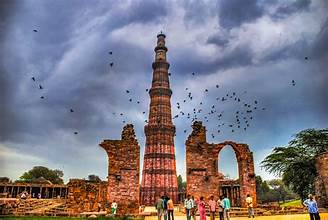The Qutub Minar, located in Delhi, India, is an architectural marvel and a UNESCO World Heritage Site. Standing tall at a height of 73 meters, it is the tallest brick minaret in the world. The Qutub Minar is not only a magnificent structure but also holds immense historical and cultural significance. Let’s delve into the fascinating history and architectural brilliance of this iconic monument.
The construction of the Qutub Minar began in the year 1192 by Qutub-ud-din Aibak, the first Muslim ruler of Delhi. It was completed by his successor Iltutmish. The minaret is built primarily of red sandstone, adorned with intricate carvings and verses from the Quran. The unique feature of the Qutub Minar is its five distinct storeys, each marked by intricately designed balconies.
The first three storeys of the minaret showcase beautiful fluted designs and intricate calligraphy. The fourth storey presents a change in architectural style with angular and circular patterns, reflecting the influence of different dynasties. The final storey is a circular balcony, offering panoramic views of the surrounding area.
At the base of the Qutub Minar is the Quwwat-ul-Islam Mosque, one of the oldest mosques in India. Its construction involved reusing many Hindu and Jain temples, resulting in a captivating blend of Hindu, Islamic, and Persian architectural elements. The mosque features intricately carved pillars, arched gateways, and a prayer hall adorned with verses from the Quran.
However, the Qutub Minar has faced the test of time and endured several incidents, including earthquakes and lightning strikes. As a result, the original five-storey structure was damaged, and only four storeys remain today. Nevertheless, the monument continues to captivate visitors with its grandeur and historical significance.
Apart from its architectural magnificence, the Qutub Minar holds great historical importance. It is considered a symbol of the Muslim rule in India and represents the architectural prowess of the Delhi Sultanate. The minaret also serves as a reminder of the rich cultural exchange and synthesis between different communities and religions.
Visiting the Qutub Minar is a fascinating journey through history. As one explores its intricate carvings and architectural details, it evokes a sense of awe and admiration for the craftsmanship of the bygone era. The surrounding complex, with its lush green gardens and other historical structures like the Alai Darwaza and Iron Pillar, further adds to the charm of the place.
In conclusion, the Qutub Minar is not merely a towering structure but a testament to India’s rich history and architectural brilliance. It stands as a proud reminder of the cultural diversity and artistic achievements of ancient times. A visit to this iconic monument is a must for anyone seeking to delve into the heritage of Delhi and witness the grandeur of the Qutub Minar firsthand.

